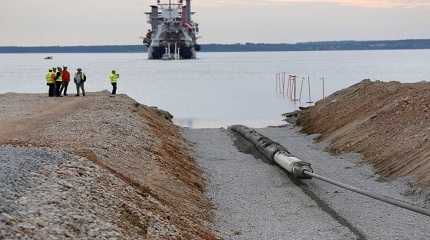
OSLO, Oct 20 (Reuters) - A Chinese container vessel and a Russian-flagged ship investigated over damage to a gas pipeline in the Gulf of Finland were also present at the sites, and at around the time two telecoms cables sustained damage, vessel tracking data showed.
Early on Oct. 8, a gas pipeline and a telecoms cable connecting Finland and Estonia were broken, in what Finnish investigators say may have been deliberate sabotage.
On Tuesday, Sweden said a third link, connecting Stockholm to Tallinn, had been damaged at roughly the same time as the other two.
The incidents have stoked concerns about the security of energy supply in the wider Nordic region, prompted NATO to ramp up patrols in the Baltic Sea and Helsinki to contact Moscow and Beijing via diplomatic channels about the incidents.
TWO SHIPS
Only two ships were present at all three sites around the approximate time when the damage occurred, according to data from MarineTraffic, a ship-tracking and maritime analytics provider.
The ships are: the NewNew Polar Bear, a Chinese container ship travelling between China and Europe via the Northern Sea Route in the Arctic, and the Sevmorput, a nuclear-powered cargo vessel transiting between Murmansk and St. Petersburg.
Finnish investigators, in charge of the pipeline investigation, are probing both ships, as well as others, they said on Tuesday.
Based on vessel tracking data, Reuters matched the ships' path with the locations where the damage occurred at all three sites.
The locations match the movements of military and service vessels deployed to investigate the incidents.
Finnish and Estonian authorities have also established restricted navigation zones around the incident sites in the Gulf of Finland.
In the first incident, which involved the Swedish-Estonian telecoms cable, the NewNew Polar Bear passed over the link at 1813 EET (1513 GMT) on Oct. 7, while the Sevmorput passed over the cable at 2008 EET, some 4 km (2.6 nautical miles) to the west of the incident site.
The cable's operator, Arelion, said the incident occurred in the "afternoon of Oct. 7". It declined to give a specific time.
In the second incident, involving the gas pipeline linking Finland and Estonia, the NewNew Polar Bear passed over the infrastructure at 0120 EET on Oct. 8 (2220 GMT on Oct. 7), while the Sevmorput passed over it eight minutes earlier, at 0112 EET.
The time the NewNew Polar Bear crossed the pipeline matches the time when Norwegian seismologists registered a small seismic event in the pipeline's vicinity.
The pipeline's operators, Gasgrid and Elering, have said the gas leak occurred between 0100 and 0200 EET on Oct. 8 (2200-2300 GMT, Oct. 7).
In the third incident, on the Finland-Estonia telecoms link, the NewNew Polar Bear crossed it at 0249 EET on Oct. 8 (2349 GMT, Oct. 7), while the Sevmorput crossed it at 0226 EET the same day (2326 GMT, Oct. 7).
The cable's operator, Elisa, has declined to say when the damage occurred. The Estonian Navy said the cable was damaged about two hours after the Balticconnector incident.
NewNew Shipping, the owner and operator of the NewNew Polar Bear, declined to comment when contacted by Reuters
The Russian authority responsible for nuclear-powered vessels, Atomflot, has denied to Reuters that one of its ships had been involved. On Friday it declined to give fresh comment.
Russian President Vladimir Putin has dismissed as "rubbish" the idea that Russia damaged the Finnish-Estonia gas pipeline.




